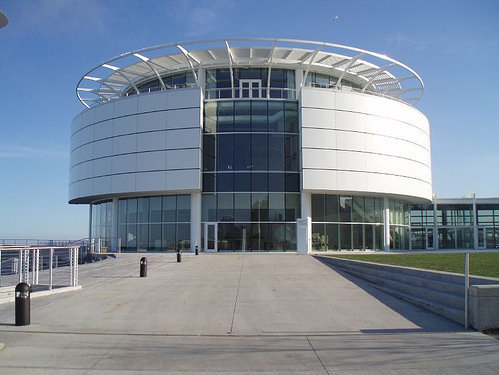In the last 10 years, the landscape, tradition and development of Milwaukee's architecture has undeniably grown. Redevelopments in the Brewer's Hill and Harambee neighborhoods, continued growth in the Historic Third Ward and the design of international masterpieces along the Lakefront all forge a newfound vitality and maturity in Milwaukee's architectural culture.
Taking a cue from the Milwaukee Public Museum's original exhibit, Robert Powers' "Milwaukee Streets" photo and essay blog explores the roots, culture and architecture of the streets of Milwaukee.
Having lived in Philadelphia, St. Louis, Milwaukee and Chicago, Powers' knowledge of urban architecture is as much the result of experience as education. Powers lived in Milwaukee for over seven years, completing a three year graduate program in architecture at UWM, and just recently moving to Chicago in search of employment opportunity.
Complimented by vivid photography, Powers' blog is both a venue to vent and praise urban architecture as well as a means to spark community conversation. Powers began writing the "Milwaukee Streets" blog over two years ago after writing a similar blog in St. Louis. He currently writes on Chicago as well.
"Each of those sites has their own story. In St. Louis, I saw so many historic building being torn down and left to rot felt compelled to document it. The Milwaukee blog is more focused on critiques of urban design and how the city fits together. My Chicago blog is really just a place to say wow, look at this cool thing I found," Powers says.
Whatever the reason, Powers' blogs explore elements of architecture both physical and intellectual. From new developments on the East Side or the addition of Discovery World to the city's skyline to abandoned Asian influenced architecture on the city's South Side, Powers seems to thrive on Milwaukee's urban transition.
Pondering decisions on new construction or analyzing the direction of redevelopments, Powers looks at the city's landscape as a collection of small parts creating a one, dynamic whole.
Avidly a fan of Milwaukee, Powers qualifies his statements on architecture; understanding the role of culture and landscape in the creation of the physical world.
"Architecture today kind of lost the certainty of doing something good. Modernists insisted they were doing a great thing and while that cost us several historic buildings, namely two Milwaukee train stations in the 1960s, we no longer have such a distinct style," Powers says.
Powers is admittedly partial to architectural styling's from the late 1950s to early 1970s. A time period he insists is generally disdained and forgotten, Powers finds originality in the simple structure and unique experimentation of that time period.
"Architecture from that time has its own delight. The blue building that used to be on the corner of Farwell Avenue and North Avenue is a very middle of road example but you don't see a building made with blue bricks and silver trim every day," Powers says.
Inevitably, conversation with Powers turns to old versus new. Powers' blog undeniably looks at the installation of new development and the preservation of historic construction under the same lens and while Powers speaks with disappointment of the loss of history in St. Louis, he believes the story is quite different for Milwaukee.
"There has been some loss in Milwaukee but on the balance they've done a good job of keeping downtown intact. You don't see gaping holes in architecture on Wisconsin Avenue. But sadly, downtown used to extend to Park East and while it's really progressive that the freeway came down, it would've been better if it'd never gone up," Powers says.
As Powers explains his opinions on Milwaukee's architecture, he hesitates to make any absolute expert claims, but reveals an appreciation encompassing more than Historic Downtown or the Victorian East Side.
"I think the area west and north of Marquette is really undervalued and at some point people are going to realize they can get a mansion just minutes from downtown. There are also parts of the South side I'm very fond of; not distinct architecture but the liveliness it maintains as an immigrant community," Powers explains.
Powers' blog and conversation exposes a self-imposed "fanatical documenter." Connecting to urban spaces by exploring, analyzing and appreciating architecture, Powers embodies an artist in constant search of a muse.
"Milwaukee's Germanic roots are a very visible connection to the city's past. There have been incredible modernizations in last ten years- the train station, Milwaukee Art Museum or Discovery world. The city developed a contemporary style maybe not derived by Calatrava but definitely influenced by him," Powers explains.
Powers acknowledges there is no absolute formula for great architecture but his own taste draws him to elements of overt ornamentation that creates constantly changing shadow.
"I really love deep overhangs and heavy three dimensional ornaments; the contrast between sunlight and shadow. Things like Calatrava's Brise Soleil is purely decoration and I think that's a perfectly legit reason to put it there. It's a particularly expensive example but a pretty fine intention," Powers says.
OnMilwaukee.com staff writer Maureen Post grew up in Wauwatosa. A lover of international and urban culture, Maureen received a bachelor’s degree in sociology from the University of Wisconsin-Madison.
After living on the east side of Madison for several years, Maureen returned to Milwaukee in 2006.
After a brief stint of travel, Maureen joined OnMilwaukee.com as the city’s oldest intern and has been hooked ever since. Combining her three key infatuations, Milwaukee’s great music, incredible food and inspiring art (and yes, in that order), Maureen’s job just about fits her perfectly.
Residing in Bay View, Maureen vehemently believes the city can become fresh and new with a simple move across town.



